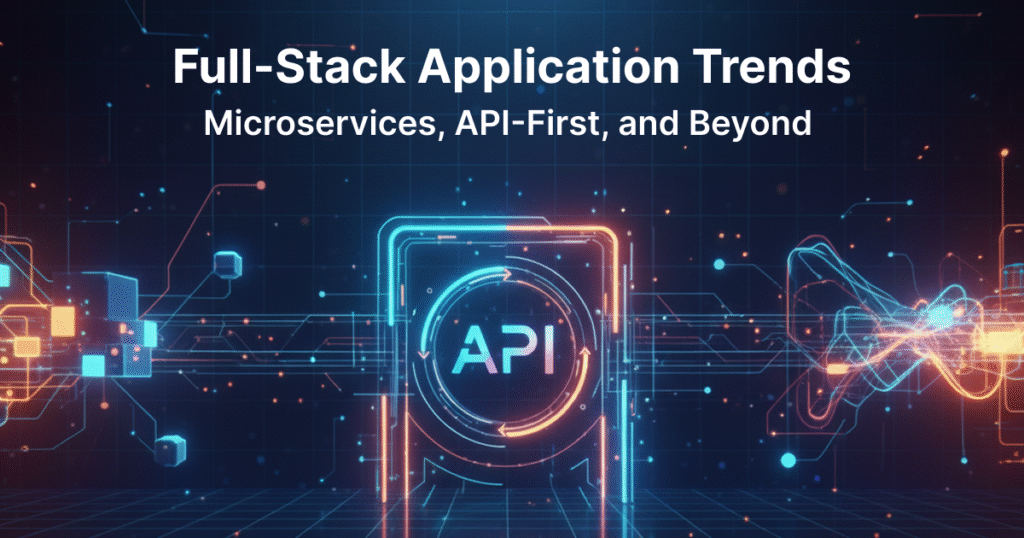In today’s fast-changing digital landscape, full-stack developers face a growing array of tools, frameworks, and architectural choices. Businesses expect software that is fast, scalable, and resilient while being cost-efficient to operate. As a result, Full-Stack Application Trends are shifting toward approaches that embrace flexibility and long-term adaptability. Among the most notable shifts are the rise of Microservices Architecture, the move toward API-First Development, and the widespread adoption of the Cloud-Native Application model.
Let’s explore these trends in detail and what they mean for organizations building the next generation of digital experiences.

Microservices Architecture: Building with Agility
One of the most prominent Full-Stack Application Trends is the adoption of Microservices Architecture. Instead of building large, monolithic systems, organizations are decomposing applications into smaller, independently deployable services.
Benefits of Microservices
Scalability: Teams can scale individual services based on demand, reducing resource waste.
Flexibility: Different services can use different programming languages or databases, allowing teams to choose the best tool for the job.
Resilience: Failures in one service do not necessarily bring down the entire system.
Faster Delivery: Smaller codebases make it easier for teams to test, deploy, and update features.
For full-stack developers, microservices introduce complexity in areas such as service communication, monitoring, and deployment pipelines. However, this architecture aligns well with cloud platforms and DevOps practices, making it a natural progression for modern teams.
API-First Development: Designing for Integration
The second major shift is the rise of API-First Development. In this approach, APIs are not afterthoughts but the foundation of the application. Developers design, document, and test APIs before building the user interface or business logic.
Why API-First Matters
Consistency: APIs serve as contracts that define how services communicate, reducing misalignment between teams.
Faster Prototyping: Front-end and back-end teams can work in parallel once the API design is finalized.
Ecosystem Expansion: A robust API allows businesses to integrate with partners, third-party tools, and customer applications more easily.
Future-Proofing: As new devices, channels, or clients emerge, APIs ensure that services can adapt without rewriting core systems.
An API-first mindset also improves developer experience, encouraging the use of tools like OpenAPI, Postman, or GraphQL to design and validate interfaces before a single line of code is shipped.
Cloud-Native Applications: Scaling with the Cloud
Closely tied to microservices and APIs is the concept of the Cloud-Native Application. This trend emphasizes designing applications that fully leverage the advantages of cloud platforms rather than simply lifting and shifting legacy workloads.
Characteristics of Cloud-Native Apps
Containerization: Using tools like Docker and Kubernetes to standardize deployment and ensure portability.
Elastic Scaling: Automatically adjusting resources based on demand, improving cost efficiency.
DevOps & CI/CD: Integrating continuous delivery practices for rapid, reliable releases.
Observability: Embedding monitoring, logging, and tracing for proactive issue detection.
For full-stack developers, cloud-native thinking means building applications that are resilient by default and capable of evolving alongside user needs. It also shifts responsibility toward mastering infrastructure-as-code, deployment pipelines, and cloud service management.
Beyond the Buzzwords: What’s Next?
While Microservices Architecture, API-First Development, and Cloud-Native Applications are shaping current Full-Stack Application Trends, new forces are already emerging:
Serverless Computing: Developers write functions that run on demand, without worrying about servers or scaling.
Edge Computing: Pushing workloads closer to users for low-latency experiences, especially in IoT and real-time applications.
AI Integration: Embedding machine learning models into full-stack workflows, from personalized recommendations to intelligent automation.
Low-Code/No-Code Platforms: Enabling business teams to create apps faster while developers focus on complex custom solutions.
These directions point to an ecosystem where full-stack development is less about mastering one language or framework and more about understanding systems, contracts, and distributed architectures.
Practical Advice for Teams
For organizations wondering how to embrace these trends, here are a few actionable steps:
1.Start Small with Microservices – Identify a high-impact module that can be safely separated and deployed independently.
2.Adopt API-First Habits – Use design-first tools and involve all stakeholders early in the API lifecycle.
3.Leverage Managed Cloud Services – Instead of self-hosting databases, queues, or caches, move to managed offerings to reduce operational overhead.
4.Invest in DevOps Skills – Empower your team with automation, CI/CD pipelines, and infrastructure-as-code expertise.
5.Measure What Matters – Track metrics like deployment frequency, lead time, error rates, and user experience to validate modernization efforts.
Conclusion
The landscape of full-stack development is rapidly evolving. Full-Stack Application Trends now revolve around modular design, integration-first thinking, and cloud-native strategies. Microservices Architecture enables agility and resilience, API-First Development fosters collaboration and scalability, and Cloud-Native Applications ensure that systems can grow with demand.
By embracing these trends, businesses are not just keeping pace with technology—they are positioning themselves to innovate faster, reduce costs, and deliver better experiences for users. For developers and leaders alike, the challenge is clear: stay adaptable, experiment boldly, and invest in the practices that turn trends into long-term advantages.
Search
Categories

Author
-
Sivaraman is a front-end developer with 3 years of experience building clean, responsive web interfaces. He’s always curious about new technologies and enjoys putting ideas together from scratch—whether it’s a small feature or a full layout. When he gets stuck on a tricky bug, music is his go-to fix. With his favorite tracks playing, the solutions often start to click. Outside of coding, he’s a huge cricket fan—both watching and playing whenever he gets the chance. It’s his favorite way to relax, compete, and have some fun away from the screen.
